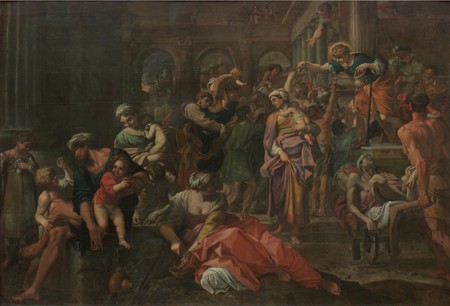Systematic catalogs represent the most important contribution that museums can make to scholarly research, and their production ranks among a curator’s essential tasks. Through years of familiarity with a collection, a curator gains detailed knowledge not only of the material aspects of a work of art but also of its collection and research history. Naturally, many museum departments, first and foremost conservation, play their part in this undertaking. Research carried out within the museum generates a foundation for further scholarly work at universities across all areas of the humanities. At the same time, the insights that a systematic catalog yields can inform
Given the considerable challenges of funding programs and personnel that face many museums, however, curators and conservators often do not have time to research and work on the collection’s holdings. Therefore, I am all the more grateful to CASVA for offering me the truly exceptional opportunity of devoting an entire academic year to concentrated research on the
Although the origins of the Gemäldegalerie can be traced to the Kunstkammer founded by Augustus, elector of Saxony, in 1560, the present holdings of Bolognese artists are largely the result of acquisitions made by Augustus III, elector of Saxony and king of Poland, in the mid-eighteenth century. Because he was chiefly interested in such well-known Bolognese
Producing a systematic catalog first entails extensive research into each work and putting the findings in the context of a critical summary of existing scholarly opinion. This process starts with the work’s material condition and conservation history. Second, research has to be conducted regarding the method of painting and the existence of any preliminary sketches. Third are the work’s attribution, its date, and its position in the artist’s oeuvre. Fourth are
During my stay at CASVA, I carried out research on the core group of works produced by Bolognese artists between 1580 and 1660. My research began with the Gemäldegalerie’s outstanding collection of nine paintings by Annibale Carracci. Since all these works were completed between 1583 and 1595, they also offer insights into the Carracci’s new aesthetic approach, which was so prominent in shaping the development of the Bolognese school. This research also integrated findings from recent investigations using modern imaging technologies at the Staatliche Kunstsammlungen Dresden. As a result, it was possible to elaborate for the first time the complex process of pictorial composition, with all its pivotal changes, in Annibale’s Saint Roch Distributing Alms. This
The staff and fellows at CASVA provided a truly inspiring environment for this work, especially the members of the Malvasia project. A wide range of other departments at the National Gallery of Art, in
